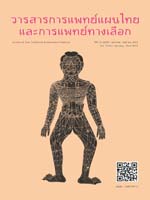The Origin of Sen Prathan Sip
Main Article Content
Abstract
Sen Prathan Sib or ten primary energy lines (paths) in traditional Thai massage are Ida, Pingala, Sushumna, Kalathari, Sahasrangsi, Dwari, Chandabhusang, Rujam, Sukumang, and Sikhini. Knowing about the origin of Sen Prathan Sib or how the knowledge about the ten energy lines was derived is very important because it will connect us to the root of knowledge and the theory of the Sen (energy lines). The traditional standard textbooks of traditional Thai massage which were systematically recorded are Massage Illustrations (Pharb Phaen Nuad) of Wat Phra Chetuphon (a Buddhist temple), the Textbook of Etiology
(Rok Nithan Khamchan 11) with a section on Sen Sib (ten energy lines), and Massage Scripture Volumes 1 and 2 in the Royal Medical Textbook (Tamra Vechasart Chabab Luang) of King Rama V, but no mention was made of the energy line’s origin. A comparison Sen Prathan Sib theory with Nadis (energy lines or paths) of yoga shows that both of them have some similarities such as the belief in the routes of wind element, the number of routes or lines (totaling 72,000), and three lines of Sen Prathan Sib and three lines of Nadis having the same names (i.e. Ida, Pingala, Sushumna). The main path of Ida in Thai massage is on the left side of the body and Pingala is on the right side, while the Nadi Ida and Nadi Pingala cross each other on the left and right sides of the body. Moreover, the wind line of Ida in Thai massage and Nadi Ida are the same (wind of the moon); and the wind of Pingala in Thai massage and Nadi Pingala
are the same (wind of the sun). The main paths of Sushumna in Thai massage and Nadi Sushumna are in the midline of the body. However, there is no evidence of the other lines of Sen Prathan Sib, except that in the Thai Massage Textbooks there are records of the pressure points in healing symptoms and the relationship between Sen Prathan Sib and the elements including the etiology of their deterioration and malfunctioning as well as the effect of seasonal changes. Such matters are not mentioned in any yoga textbooks, which however contain some information about illness etiology and diagnosis. It is believed that Thai massage therapists have adopted such principles of etiology and diagnosis and got them modified for application; later on they became the Thai massage wisdom. That was because, in Ayurvedic massage, oil is used and it is a part of the Panja Karma (five actions) which do not mention about Sen Prathan Sib or the 14 Nadis in the yoga principle.
Article Details
References
2. สุจิตต์ วงศ์เทศ. สุวรรณภูมิ ต้นกระแสประวัติศาสตร์ไทย. กรุงเทพมหานคร: สำนักพิมพ์มติชน; 2549.
3. วิชัย โชควิวัฒน สุวิทย์ วิบุลผลประเสริฐ และ ประพจน์ เภตรากาศ, (บรรณาธิการ). รายงานการสาธารณสุขไทย ด้านการแพทย์
แผนไทย การแพทย์พื้นบ้าน และการแพทย์ทางเลือก 2552-2553.นนทบุรี: สามเจริญพาณิชย์ (กรุงเทพฯ); 2553.(456 หน้า)
4. มูลนิธิสาธารณสุขกับการพัฒนา. ตำราเส้นสิบฉบับอนุรักษ์.พิมพ์ครั้งที่ 1. กรุงเทพมหานคร: พิมพ์ดี; 2554. (136 หน้า)
5. กรมศิลปากร. สมุดภาพโคลงฤๅษีดัดตน. กรุงเทพมหานคร:อมรินทร์พรินติ้งแอนด์พับลิชชิ่ง; 2551. (160 หน้า)
6. สถาบันภาษาไทย กรมวิชาการ กระทรวงศึกษาธิการ.แพทย์ศาสตร์สงเคราะห์: ภูมิปัญญาทางการแพทย์และมรดกทางวรรณกรรมของชาติ. กรุงเทพมหานคร: คุรุสภาลาดพร้าว;2542. (1,010 หน้า)
7. หอสมุดแห่งชาติ กรมศิลปากร. ตำราเวชศาสตร์ฉบับหลวง รัชกาลที่ 5 เล่ม 1-2. กรุงเทพมหานคร: กรมศิลปากร; 2542.(916 หน้า)
8. แพทย์พงษ์ วรพงศ์พิเชษฐ. โยคะเพื่อการพัฒนาร่างกายและ จิตใจ. พิมพ์ครั้งที่ 1. กรุงเทพมหานคร: เอช.ที.พี.เพรส; 2542.(242 หน้า)
9. Ram Kumar Rai. Shiva Svavodaya. Prachya Prakashan, Varanasi; 1997.


